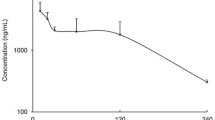Summary
Angiogenesis is normally a highly regulated process that occurs during development, reproduction, and wound repair. However, angiogenesis can also become a fundamental pathogenic process in cancer and several other diseases. To date, the synthesis of angiogenesis inhibitors has been researched in several ways also starting from bioactive plant compounds. In the present study, we tested both in an angiogenesis bioassay and in ovarian cell culture, the potential antiangiogenic effect of a natural-derived benzo[k,l]xanthene lignan (5). This unusual compound was synthesized through the biomimetic dimerization of CAPE (Caffeic Acid Phenetyl Ester), a bioactive component of honeybee propolis. The lignan showed a significant, dose-related inhibitory effect on new vessel growth in the angiogenesis bioassay and it inhibited Vascular Endothelial Growth Factor secretion in ovarian cell culture. Therefore, we indicate the natural-derived benzo[k,l]xanthene lignan 5 as a potential new angiogenesis inhibitor.




Similar content being viewed by others
References
Nussenbaum F, Herman IM (2010) Tumor angiogenesis: insights and innovations. J Oncol 132641. Epub 2010
Naumov GN, Akslen LA, Folkman J (2006) Role of angiogenesis in human tumor dormancy: animal models of the angiogenic switch. Cell Cycle 5:1779–1787
Murukesh N, Dive C, Jayson GC (2010) Biomarkers of angiogenesis and their role in the development of VEGF inhibitors. Br J Cancer 102:8–18
Varinska L, Mirossay L, Mojzisova G, Mojzis J (2010) Antiangiogenic effect of selected phytochemicals. Pharmazie 65:57–63
Apers S, Paper D, Buergermeister J, Baronikova S, Van Dyck S, Lemière G, Vlietinck A, Pieters L (2002) Antiangiogenic activity of synthetic dihydrobenzofuran lignans. J Nat Prod 65:718–720
Jaganathan SK, Mandal M (2009) Antiproliferative effects of honey and of its polyphenols: a review. J Biomed Biotechnol 2009:830616. Epub 2009
Daquino C, Rescifina A, Spatafora C, Tringali C (2009) Biomimetic synthesis of natural and ‘unnatural’ lignans and neolignans by oxidative coupling of caffeic esters. Eur J Org Chem 2009:6289–6300
Souza da Silva SA, Souto AL, de Fatima Agra M, Leitao da-Cunha E, Barbosa-Filho JM, Sobral da Silva M, Braz-Filho R (2004) A new arylnaphthalene type lignan from Cordia rufescens A. DC. (Boraginaceae). ARKIVOC 6:54–58
Shi S, Zhang Y, Huang K, Liu S, Zhao Y (2008) Application of preparative high-speed counter-current chromatography for separation and purification of lignans from Taraxacum mongolicum. Food Chem 108:402–406
Tanaka T, Nishimura A, Kouno Y, Nonaka G, Yang CR (1997) Four new caffeic acid metabolites, yunnaneic acids E - H, from Salvia yunnanensis. Chem Pharm Bull 45:1596–1600
Basini G, Bussolati S, Santini SE, Bianchi F, Careri M, Mangia A, Musci M, Grasselli F (2008) Hydroxyestrogens inhibit angiogenesis in swine ovarian follicles. J Endocrinol 199:127–135
Basini G, Bianco F, Grasselli F (2005) Epigallocatechin-3-gallate from green tea negatively affects swine granulosa cell function. Domest Anim Endocrinol 28:243–256
Basini G, Baioni L, Bussolati S, Grolli S, Kramer LH, Wagner GF, Grasselli F (2010) Expression and localization of stanniocalcin 1 in swine ovary. Gen Comp Endocrinol 166:404–408
Basini G, Bussolati S, Santini SE, Bianchi F, Careri M, Mangia A, Musci M, Grasselli F (2007) Antiangiogenesis in swine ovarian follicle: a potential role for 2-methoxyestradiol. Steroids 72:660–665
Basini G, Bussolati S, Santini SE, Grasselli F (2008) Reactive oxygen species and anti-oxidant defences in swine follicular fluids. Reprod Fertil Dev 20:269–274
Murukesh N, Dive C, Jayson GC (2010) Biomarkers of angiogenesis and their role in the development of VEGF inhibitors. Br J Cancer 102:8–18
Carrillo S, Chamorro M, Rodriguez-Gago B, Alvarez MJ, Molina MJ, Rodríguez-Barbosa JI, Sánchez A, Ramírez P, Muñoz A, Domínguez J, Parrilla P, Yélamos J (2002) Isolation and characterization of immortalized porcine aortic endothelial cell lines. Vet Immunol Immunopathol 89:91–98
Bianco F, Basini G, Grasselli F (2005) Angiogenic activity of swine granulosa cells: effects of hypoxia and vascular endothelial growth factor Trap R1R2, a VEGF blocker. Domest Anim Endocrinol 28:308–319
Barboni B, Turriani M, Galeati G, Spinaci M, Bacci ML, Forni M, Mattioli M (2000) Vascular endothelial growth factor production in growing pig antral follicles. Biol Reprod 63:858–864
Bhadada SV, Goyal BR, Patel MM (2010) Angiogenic targets for potential disorders. Fundam Clin Pharmacol 2010 Feb 22. [Epub ahead of print]
Ahn MR, Kunimasa K, Kumazawa S, Nakayama T, Kaji K, Uto Y, Hori H, Nagasawa H, Ohta T (2009) Correlation between antiangiogenic activity and antioxidant activity of various components from propolis. Mol Nutr Food Res 53:643–651
Izuta H, Shimazawa M, Tsuruma K, Araki Y, Mishima S, Hara H (2009) Bee products prevent VEGF-induced angiogenesis in human umbilical vein endothelial cells. BMC Complement Altern Med 17:9–45
Keshavarz M, Mostafaie A, Mansouri K, Shakiba Y, Motlagh HR (2009) Inhibition of corneal neovascularization with propolis extract. Arch Med Res 40:59–61
Ahn MR, Kunimasa K, Ohta T, Kumazawa S, Kamihira M, Kaji K, Uto Y, Hori H, Nagasawa H, Nakayama T (2007) Suppression of tumor-induced angiogenesis by Brazilian propolis: major components artepillin C inhibits in vitro tube formation and endothelial cell proliferation. Cancer Lett 252:235–243
Kim JH, Lee BJ, Kim JH, Yu YS, Kim KW (2009) Anti-angiogenic effect of caffeic acid on retinal neovascularization. Vascul Pharmacol 51(4):262–267
Acknowledgements
Supported by MIUR, Ministero dell’Università e della Ricerca (PRIN, Rome, Italy), Università degli Studi di Catania (PRA, Catania, Italy) and Università degli Studi di Parma (FIL, Parma, Italy).
Author information
Authors and Affiliations
Corresponding author
Rights and permissions
About this article
Cite this article
Basini, G., Baioni, L., Bussolati, S. et al. Antiangiogenic properties of an unusual benzo[k,l]xanthene lignan derived from CAPE (Caffeic Acid Phenethyl Ester). Invest New Drugs 30, 186–190 (2012). https://doi.org/10.1007/s10637-010-9550-z
Received:
Accepted:
Published:
Issue Date:
DOI: https://doi.org/10.1007/s10637-010-9550-z




